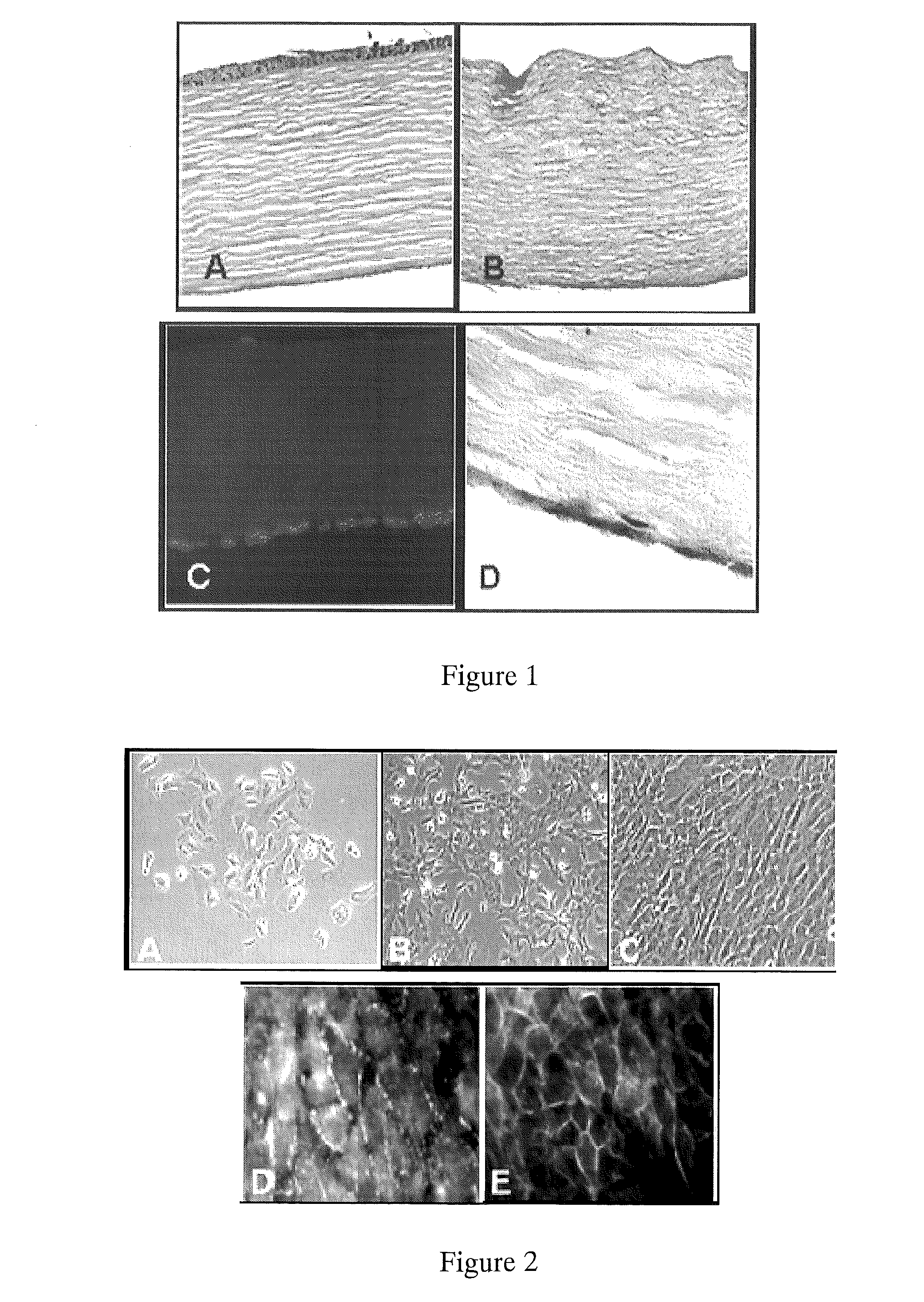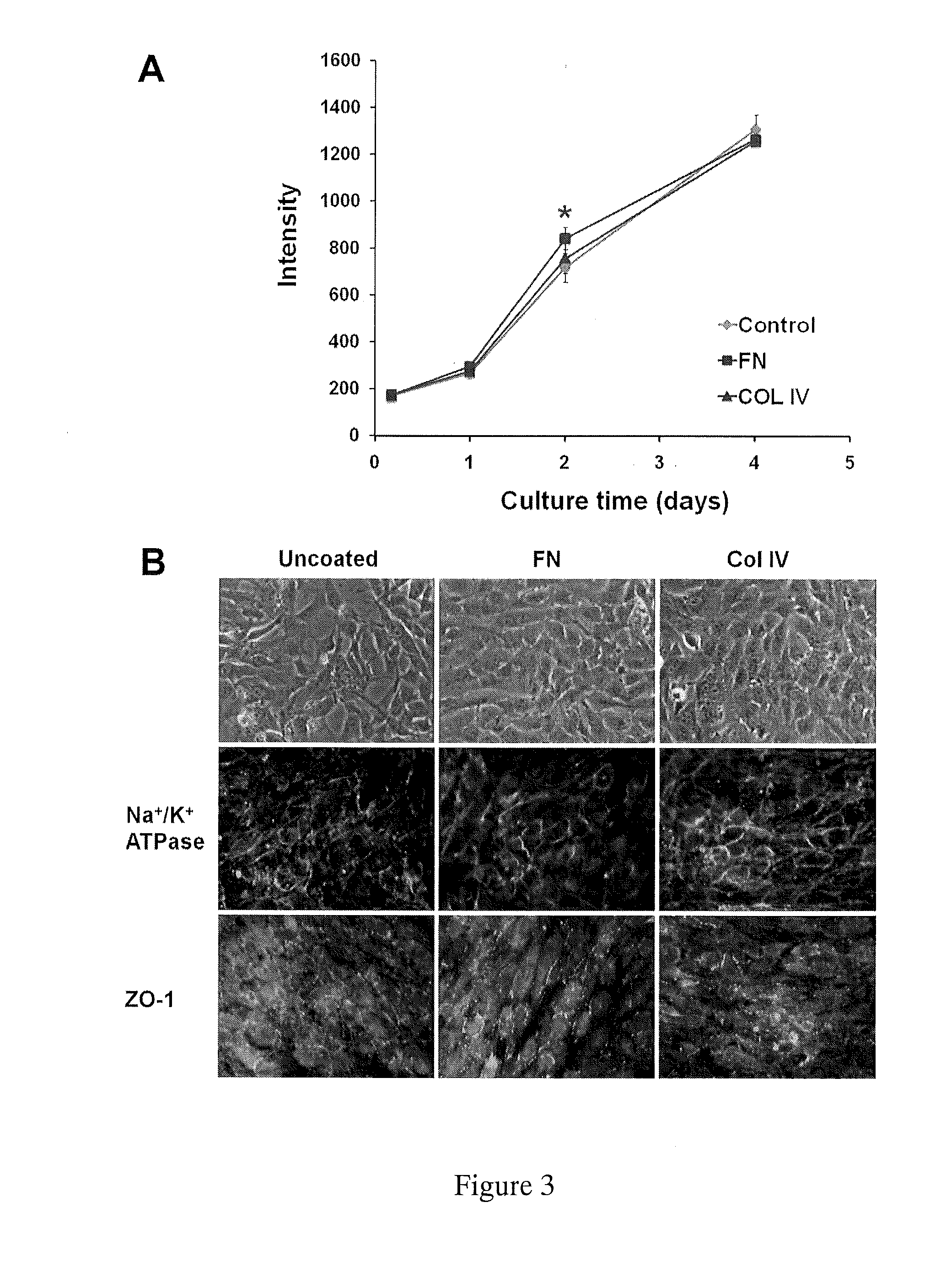Endothelial scaffolds
a technology of endothelial cells and scaffolds, applied in the field of endothelial cells, can solve the problems of corneal opacity improvement, corneal thickening, and patient wearing thick glasses for correction, and achieve the effect of reducing the risk of stroma formation
- Summary
- Abstract
- Description
- Claims
- Application Information
AI Technical Summary
Problems solved by technology
Method used
Image
Examples
example 1
[0059]Corneal scaffolds were made using a microtome to cut whole corneas (obtained from the eye bank) into 125 micron-thick slices cut parallel to the endothelial surface. These corneal slices were placed in decellularization solution (2% Triton X100, 0.1% NH4OH) for 3 days at 4° C. A native cornea (A) and a decellularized cornea (B) are shown in FIG. 1. The decellularization process removed the epithelial, endothelial, and 95% of the stromal cells. These decellularized sections were stored in PBS and kept at a 4° C. until they were used for cell seeding experiments.
example 2
Corneal Endothelial Cells (CECs)
[0060]Human CECs were collected from the basal surface of the limbus of cadaver corneas of donors 14-75 years old. The corneas were placed in a petri dish containing 0.02 g collagenase II in 10 mL PBS for each rim and incubated at 37° C. for 90 minutes. Sterile forceps and a spatula were then used to gently scrape the scleral rim of Descemet's membrane with intact endothelium. Cells removed by this process were centrifuged for 5 minutes at 1500 rpm and then resuspended in 2.5 mL EGM-2 complete culture medium containing 10% FBS and plated in the wells of a 6-well tissue culture dish.
[0061]Type IV collagen is a major component of the corneal stroma and fibronectin is an adhesive protein that is often used to coat endothelial cell-seeded culture plates. To test if the presence of extracellular matrix components affected growth rates, we plated cells on petri plates with no coating, fibronectin coating, or collagen type IV coating. There were no differenc...
example 3
Seeding the Decellularized Corneal Scaffolds
[0067]Approximately 30,000 CECs were seeded on the decellularized scaffold (8 mm diameter). Acellular corneas were placed in the bottom of a well of a 48-well dish, and the cell suspension was layered on top, allowing the seeding to take place by simple gravitational settling.
[0068]The construct was placed in EGM-2 media (Lonza, Walkersville, Md.) supplemented with fetal bovine serum (to a final concentration of 10%) for seven days, and then analyzed.
[0069]Scanning electron microscopy (SEM) was performed on fresh (frozen) samples to determine CEC coverage of the stroma. Isolated hCEC formed confluent monolayers with a phenotype typical of endothelial / epithelial cells (FIGS. 2,A&B). The decellularization process efficiently removed each of the stromal, epical and basal cell layers (FIG. 1). When seeded on the surface of decellularized corneas, hCEC formed a single cell monolayer, similar to native cornea (FIG. 1, right upper and lower panel...
PUM
 Login to View More
Login to View More Abstract
Description
Claims
Application Information
 Login to View More
Login to View More - R&D
- Intellectual Property
- Life Sciences
- Materials
- Tech Scout
- Unparalleled Data Quality
- Higher Quality Content
- 60% Fewer Hallucinations
Browse by: Latest US Patents, China's latest patents, Technical Efficacy Thesaurus, Application Domain, Technology Topic, Popular Technical Reports.
© 2025 PatSnap. All rights reserved.Legal|Privacy policy|Modern Slavery Act Transparency Statement|Sitemap|About US| Contact US: help@patsnap.com



